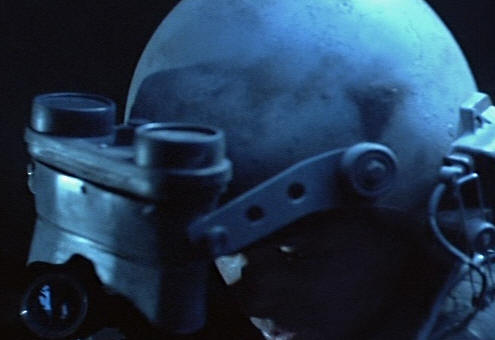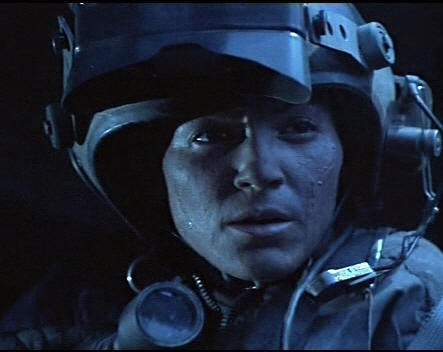

"Squad to ground and don't move! Henderson! Front and center on the double! I want you to lock your mag-gogs down and see if you can find us a way out of all of this wire! Watch your step but be quick about it! Kassar and Jones! It is your duty to shut Jules the hell up! Tranq him hard if you have to but get him quiet first and comfortable afterwards! Jeez-us! It's not like he lost his whole damn leg..." - Sgt. Mick Reynolds, 5th Recon Company
PMFVRL - PERSONAL MAGNETIC FIELD VISUAL RENDERING LENS


PSC Jan
Ferro equipped with M25A1 phased plasma rifle with flexy sight. Her combat
helmet has been modified to mount a
Model 10B PMFVRL unit with a flip-down brace. Her secure communications
equipment, headset, and personal equipment
power pack are located over her shoulder in her field harness.
______________________________
MODEL 10B PMFVRL- PERSONAL MAGNETIC FIELD VISUAL RENDERING LENS
ADOPTED NAMES:
"Magnetic Lens" or "Mag-gogs" or
"Wire finders"
MANUFACTURER: Limited quantity unit, hand-made and hand assembled by Sci /
Comp and Tech / Com core. Production requires seven different
parts salvaged or stolen from several SKYNET source machines and / or
installation supply caches.
Reproduction of most parts beyond technical or industrial capacity of mankind
at this time. Kit-bashed unit, assembled by hand
under controlled construction conditions.
TYPE:
Integrated digital signature magnetic field detector with visual display
capability.
CONSTRUCTION:
Contemporary solid state microprocessor, chipset controller, memory array and motherboard, mated to a hardened
carbon fiber / monofiber case rated as shock proof
and environmentally sealed against elements to three atmospheres or ten meters
depth. Production module intended to be integrated into Model 12 ABSS "Flexy
Sight" as an add-on option. Later units were adapted to visor mounts for
use on standard battle helmets and adjustable head bands using Standard
clip-on type attachment point. Some units modified with rail mount for use
on most standard human weapons capable of accepting combat visual aids.
Weapon and helmet mounted units can be removed and passed around to be used by
other members of the squad. Includes cable port for the use of a
standard shielded fiber optic data cable between the unit and any other
hardware equipped with a hardwire port. Component parts are as follows:
1x Series
3 Mod 4 Type 2A Digital Processor Array
1x Series
2 Mod 5 Type B3D Digital
electromagrapher
1x Series 3 Mod 3 Type By3 Digital Comparative Scan Reprocessor
1
x Model 7 Series 3 400gb flash memory storage cache
1
x Level 3, OS 4.0A, Rev 3G operating software with SIMA standard
integrated modular assumption
1
x Type 3 Mod 5 Series 3x high resolution plasma display unit (5cm x
4cm, 4.5cm x 3.8cm viewing area)
1 x Series 2 Model 3 High Speed data bus, 2.35 gb cache
ASSEMBLY TIME: 1.5
hours labor using specialized custom built assembly tools, a full metric set, a
Class IV laptop running OS 4.0 Rev 3G, a copy of Martin's GUI, a
soldering gun,
15 ml thermocouple paste, 10 ml molecular adhesive paste, custom built assembly
case, and custom built mounting brackets.
OPERATION:
Passive signature specific magnetic field detection out to five meters, active
scan out to ten meters. Active modulation with user adjustable gain
and
suppression allows for search and scan of alternate magnetic field signatures.
Touch sensitive dial provides incremental increases or
decreases in unit
capacity and search parameters.
WEIGHT:
Approximately (+ / -) 0.55kg standard, varies on an individual unit basis since
each unit is hand crafted and assembled from available salvaged
parts on a
limited production basis. Substitution of some parts for older or newer
series may increase or decrease specified weight.
Total loaded weight: 0.80 kg
DIMENSIONS:
Length overall, 12.5 centimeters
POWER SOURCE: Rechargeable Type
2d high density crystal storage matrix, optimized power conservation
subroutines, 72 hour duration at maximum use.
twenty meters and
actively scan to sixty meters.
HISTORY:
The introduction and implementation of solofilament barriers to SKYNET's installation defense systems was an early cause of casualties and concern for the Resistance. Often, a soldier would run afoul of solofilament before they knew it with nearly always fatal results. Since solofilament could be strung among the ruins by very small spinner machines which were equally hard to detect, the threat of solofilament existed both on and off the battlefield as well as around most of SKYNET's installations. Returning scout groups or salvage teams often ran into solofilament that had been threaded across their path by the smaller spinner machines which had monitored the group of humans, raced ahead of them, and set up the solofilament ambush in advance, across their path. Soldiers crawling through the ruins often were dispatched with simple solofilament strands set up across the routes they might take.
Tech-Com understood the science and physics of solofilament production but could never reproduce solofilament in any quantity that lasted very long or was useful enough to make weapons from. Solofilament was a fruit from SKYNET's rapidly branching nanotech research and development tree and as such, was far in advance of anything the humans could reproduce. The fact that solofilament was only a single molecule thick made it impossible to spot with the unaided human eye and it was that fact alone that Tech-Com developed the PMFVRL for use by soldiers moving through the field. The "magnetic lens" was at first simply a modification of the Model 12 ABSS "Flexy Sight" which allowed the soldier to detect solofilament passively at up to five meters distance (or actively at up to ten meters) by sensing the characteristic wave form of the magnetic field which kept the mono-molecular strand cohesive.
Without the structural integrity field, the solofilament fell apart on a molecule by molecule basis and simply wisped away into nothing (which scientists would argue is the wrong term to use but from a soldier's viewpoint, it suffices for descriptive purposes). The solofilament would often show up as a "spider's thread wrapped in a halo" on the magnetic lens, allowing Resistance soldiers to carefully pass through areas that had been pre-strung with static solofilament strands or avoid those areas all together.
Later modifications to the PMFVRL
produced variants that were more effective, longer ranged, and available in
monocular as well as card format (a format that could be easily carried in the
fatigues pocket of any soldier, pulled out, looked through to scan an area and
then returned to the pocket).
Some variants were produced which mounted to either the battle helmets or the
accessory headbands and these types of PMFVRL were dubbed "magnetic goggles" or
simple "mag-gogs" for short.
________________